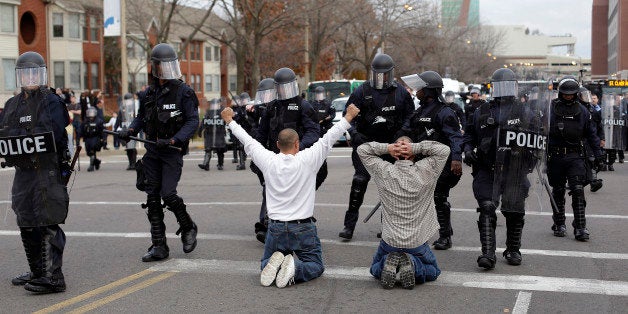
I have now had the dubious honor of witnessing three generations of riots related to race, inequality and injustice. As a teenager in the 1960s, I saw the rise of the protest march. Some were famously led by The Rev. Martin Luther King, Jr. and televised nationally. Others were organized by SNCC (Student NonViolent Coalition Committee), including a picket line in which I participated protesting Chemical Bank's involvement in S. African apartheid. Some protests became violent race riots while some gave rise to long-term institutions promoting racial equality. Those of us deeply invested in the movement grew up committed to making a difference and branched out into advocacy, education, politics, and, as I did, urban planning.
The 1960s riots took place in our major urban areas. These cities had plans, policies and politics that made the African American communities into ghettos: Harlem/NYC, Watts/LA, Newark/NJ, Detroit/MI. In every case, the catalyst leading to violence was a confrontation between a member of the Black community and law enforcement. In several cities, the protests began as peaceful demonstrations. As more aggressive protesters emerged, the police response was increasingly brutal. By the time I attended New York University in Greenwich village in 1970, the distrust and hostility on all sides was incendiary even on a good day.
In 1967, the Kerner Commission, also known as the National Advisory Commission on Civil Disorders, was appointed by President Lyndon Johnson. Its mission was to analyze the underlying causes of these urban race riots. The Commission's 1968 report stated that we were in effect two nations, black and white. Civil rights attorney James Meyerson revisits the Commission on The Huffington Post in his article, "What Is the Kerner Commission and Why It Should Be Revisited in Light of Ferguson?" He recounts the Commission's findings concerning the root causes. They included lack of economic opportunity, inadequate education institutions, and social isolation. The reinforcement of white privilege by law enforcement generated a sense of helplessness which the disrespect of the justice system magnified. The Commission described how the socio-economic system then assured the status quo. Those of us even modestly involved in the Civil Rights Movement were energized in our quest to changes our national economic, educational, and justice systems.
The reaction to the 1992 wave of race riots in Los Angeles 20-30 years later was a combination of shock, rage, disgust and discouragement New technology brought a stunning video of four white police officers beating an African American, Rodney King, into our living rooms. As difficult as it was to wrap our mind around the scene, it was virtually impossible to fathom that more than a dozen officers stood around just watching. When the officers were acquitted of police brutality, LA erupted with six days of violent protests, looting, and riots.
New Jersey Senator Corey Booker recently tweeted an article he wrote as a graduate student following the trial saying, "Not guilty ... Not shocked." Booker then cited the causes for the riots: "Poverty, estrangement, continuously aggravated by racism, overt and institutional." It's not surprising that he would revive that article now. LA seems like a distant echo of the events in Ferguson today. The root causes seem to ooze out of the 1960s like radioactive muck doing time travel.
The situation in South Central LA in the early 1990s was not pretty. According to South Central History site, the murder rates were three times higher than they are now. There was also an epidemic of crack cocaine and related crimes. The government housing projects were cauldrons of gang activities. Only when the gangs united against the police, did gang wars cease. South Central History draws a familiar picture: the lack of economic opportunity, inadequate education institutions, social isolation, and a sense of helplessness in the face of the reinforcement of white privilege by law enforcement, the justice system, and a socio-economic system that enabled the status quo.
Once again, there was an analysis of the root causes. A change in the leadership of LA law enforcement was made. Plans to remake the Watts housing project, a source of so much friction, have been in the works for years.The urban planning would have created a mixed income community that would created new infrastructure and a ripple effect of opportunities. Unfortunately, Los Angeles was eliminated in the federal granting process that would have provided the necessary leverage.
Fast forward another 20-30 years and we come to Ferguson, Missouri. Originally farm land, it grew into a railroad stop called Ferguson Station and become a suburban hub largely populated by railroad executives and former slaves. According to the city's website, Ferguson boomed during the post World War II years with manufacturers providing plentiful jobs and a parallel growth in housing and population. The jobs attracted an influx of African Americans into Ferguson and other close suburbs of the increasingly impoverished St. Louis. By 1954, Ferguson was a city for the future, one of the first in the state to have a council-manager form of government.
As the region suffered a Rust Belt fate, the result was a demographic and economic shift. Niall McCarthy describes for Forbes Magazine how the white flight intensified. Ferguson's population changed dramatically between 1990 and 2010. There was an increase from 27 percent to 67 percent for the black population and a decrease from 64 percent to 29 percent for the white population. Elizabeth Kneebone describes the poverty situation for Brookings (August 2014). She cites an unemployment rate that almost doubled from 7 percent in 2000 to 13 percent in the following decade. Earnings fell by one-third and one in four residents live below the federal poverty line while 44 percent fell below twice that level.
Despite the massive changes in Ferguson, the power structure has not changed substantially. Jeff Smith describes the system for The New York Times in his article, "In Ferguson, Black Town, White Power." Ferguson has a white mayor and a City Council with just one black member. It's police force is only 6 percent African American. The school board with six white members and one Hispanic. The board recently suspended its popular Black superintendent who then resigned.
An urban planner would agree with Smith that Ferguson's situation is similar to most of the inner ring suburbs of St. Louis. An urban planner would also agree that consolidation would promote economies of scale and new opportunities. Smith's recommendation involves major changes for the political, economic, and social structure of the city and the region. Here is where the civil rights activist in me becomes skeptical.
What will America do when every 20-30 years our racial issues come to a head? Ferguson is not an isolated case, nor is the death of an African American at the hands of a white police officer. Yet, something about Ferguson has captured the attention nationally, and even world-wide. Ferguson has become a symbol of the isolation, lack of economic opportunity, inferior education, and powerlessness that historically simmers beneath the status quo. Is this a watershed event?
The national debate is currently an inflammatory mix of accusations and counter accusations that feel too much like the early 1960s for comfort. There is debate on whether the refusal to indict the officer was fair. There is debate over whether the prosecutor was fair. There is debate over the grand jury proceedings. There is debate over the guilt or innocence of the victim. All of the debate is heated, and yet, the specifics border on irrelevant. The real debate over root causes and their solutions has barely begun.
Will the debate travel along the worn but worthy paths of urban planning and economic development? Meyerson suggests that a new federal Commission should assess and design such strategies. Smith recommends that the consolidation that would benefit Ferguson and neighboring suburbs is applicable to most metropolitan areas across the country. Los Angeles represents a strategy that includes restructuring public housing to resemble less a refugee camp and more a vibrant element in its huge metropolis.
A key question is whether the political debate leads to major urban initiatives or to a verbal rehash of civil rights issues? Given the lack of funding for Los Angeles, activists can be forgiven for their suspicions that counties, states, and the federal government won't or can't allocate the resources necessary to heal the nation's cities. Healing a chronic, and sometimes fatal, set of race-driven circumstances is not our strong suit. Historically, we have struggled with the long-term political will, material investment, and educational initiatives required to overcome the current economic inequities. Do we have what it takes now? If not, we risk becoming the poster child for that famous Abraham Lincoln quote, "A house divided against itself cannot stand."
